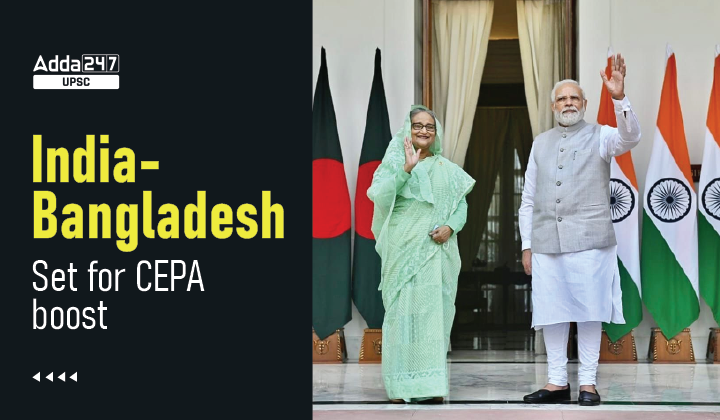Table of Contents
India-Bangladesh set for CEPA- Relevance for UPSC Exam
General Studies II-Bilateral, Regional and Global Groupings and agreements involving India.
In News
India and Bangladesh will soon commence negotiations on a Bilateral Comprehensive Economic Partnership Agreement (CEPA).
Bilateral trade between India and Bangladesh
- India is Bangladesh’s second biggest trade partner, and its largest export market in Asia.
- Despite Covid-19 related disruptions, bilateral trade grew at an unprecedented rate of almost 44 per cent from $10.78 billion in 2020-21 to $18.13 billion in 2021-22.
- In 2021-22, Bangladesh has emerged as the largest trade partner for India in South Asia and the fourth largest destination for Indian exports worldwide.
- India’s main exports to Bangladesh are raw cotton, non-retail pure cotton yarn, and electricity, and its main imports from the country are pure vegetable oils, non-knit men’s suits, and textile scraps.
What is CEPA?
- The partnership agreement or cooperation agreement is more comprehensive than a Free Trade Agreement (FTA).
- CECA/CEPA also looks into the regulatory aspect of trade and encompasses an agreement covering the regulatory issues.
- CECA have the widest coverage. CEPA covers negotiation on the trade in services and investment and other areas of economic partnership.
- It may even consider negotiation in areas such as trade facilitation and customs cooperation, competition, and IPR.
- India has signed CEPAs with South Korea and Japan.
CEPA Objectives
- While informal talks on CEPA have been happening since 2018, officials said that the pandemic has brought urgency.
- Chinese investments were an initial trigger for India, but New Delhi and Dhaka want to step up the pace following the economic shock faced by the two economies.
- The CEPA is likely to focus on trade in goods, services, and investment, with a key objective being the reduction of the trade gap between the two countries.
- As Bangladesh prepares to graduate into a developing nation by 2026 — after which it may no longer qualify for trade benefits that it currently enjoys as a least-developed country — it is keen to clinch the CEPA in a year.

The Existing Frameworks
The current institutional frameworks for trade and investment include:
- During the visit of Prime Minister Modi to Bangladesh in June 2015, the bilateral trade agreement between the two countries was renewed for a period of five years with a provision for auto renewal.
- Under the provisions of the South Asian Free Trade Area (SAFTA), Bangladesh extends preferential tariffs to Indian exports of products outside the ‘sensitive list’ of 993 items.
- In 2011, India announced duty-free, quota-free access to Bangladesh for all tariff lines except tobacco and alcohol.
- An Agreement on Promotion and Protection of Investments has been in force since 2011.
- Joint Interpretative Notes to the agreement were signed during the visit of the Indian Finance Minister to Bangladesh in October 2017.
- To facilitate trade and transit through inland waterways, a Protocol on Inland Waterways Trade and Transit (PIWTT) has been in place since 1972. It was renewed in 2015.
- Direct sea movement of containerized/ bulk/ dry cargo began after the signing of a Memorandum of Understanding (MoU) on Coastal Shipping in June 2015.
- MoUs were signed in 2015 on the use of the Chittagong and Mongla Ports for Movement of Goods to and from India.
- The MoU on Border Haats on the India-Bangladesh border was renewed in April 2017 during the visit of Prime Minister Hasina to India. Currently, four Border Haats — two each in Meghalaya (Kalaichar and Balat) and Tripura (Srinagar and Kamalasagar) — are functional.
Students can check the Types of Trade agreements from the link given below




 TSPSC Group 1 Question Paper 2024, Downl...
TSPSC Group 1 Question Paper 2024, Downl...
 TSPSC Group 1 Answer key 2024 Out, Downl...
TSPSC Group 1 Answer key 2024 Out, Downl...
 UPSC Prelims 2024 Question Paper, Downlo...
UPSC Prelims 2024 Question Paper, Downlo...





